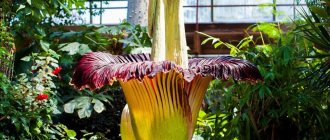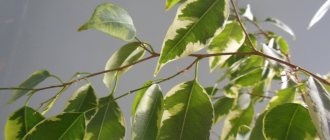When choosing plants to grow at home, first study the features of their content and appearance.
This allows you to make the right choice: determine the most attractive flower that is easy to maintain, relying on your own knowledge and skills.
But not all varieties are suitable for an apartment or house. There are plants that contain poison, release harmful substances into the environment, or otherwise affect humans.
When there are children or one of the family members is allergic, you need to be more careful about the question of which flowers should not be kept in the house.
Pay attention to the external signs of such plants in order to recognize the danger in time.
Poisonous flowers
10. Kalmia latifolia
This plant is also known as mountain laurel, and it begins to bloom with soft pink or white flowers in late spring. This flower is magnificent, but underneath its graceful appearance beats the heart of a killer.
© seven75/Getty Images
The flower produces two toxins - andromedotoxin and arbutin. The first is much more dangerous because it simultaneously provokes one part of the heart to beat faster and the other slower. In a healthy person, the heart has a natural “gate” that blocks half of the electrical impulses entering the organ.
Andromedotoxin causes the development of Wolff-Parkinson-White syndrome, which destroys this gate, allowing all impulses to enter the heart. Result? Sudden cardiac death.
But this only happens when you receive too large a dose of this toxin. If you receive a smaller dose, you will also die, but this will not happen so quickly. Vomiting appears first. After about an hour, your breathing will slow, you will lose the ability to control your muscles, then you will fall into a coma and die.
The whole problem is that you can’t even eat honey from a bee that lands on this flower, because all the toxic properties of the flower are transferred to honey.
The Greeks called this kind of honey crazy, and used it to defeat Xenophon in 400 BC.
9. Godson
Ragwort is a very common wildflower and an important part of the local ecosystem. Almost 80 species of insects feed on this plant, and for 30 species it is the only source of food.
Therefore, conservation of this plant is important.
© Tom Boss/Getty Images
This is good news for insects, but bad news for everyone else. The World Health Organization has confirmed that ragwort contains at least 8 toxic alkaloids, and possibly as many as 10.
The problem is that unlike most poisons, which leave the body quickly, godson alkaloids accumulate in the liver over a long period of time. The buildup of toxins leads to cirrhosis of the liver, a condition in which healthy cells begin to slowly degenerate into unruly masses of scar tissue.
The liver is a very strong organ and will continue to function normally until 75 percent of it is destroyed.
But by the time symptoms begin to appear, the damage is usually irreversible.
The main symptoms include loss of coordination, blindness, stabbing pain in the abdomen, and yellow eyes due to bile pigment that fills the surface membrane of the organ of vision.
Unfortunately, this is another toxin that can end up in honey.
, it is also sometimes present in the milk of goats, which love to eat godsons. Moreover, during attempts to remove this plant from the fields, toxins can enter the farmer's body through the skin of the hands.
The danger of Moorish lawns
In a short informational article, it is not possible to acquaint the reader with all the poisonous, beautifully flowering and decorative leafy garden plants. But even the information listed above gives an idea of what plants we are friends with, without suspecting their true “character”.
Moorish lawn
Today, more and more often, dachas and house plots are used for relaxation, rather than daily work in vegetable beds and gardens. It is fashionable to design recreation areas in the style of Moorish lawns, which actually represent a certain area planted with a variety of field plants.
For such a lawn, 10-40 species of beautifully flowering field plants are selected, mixed and sown. The lawn is not mowed until the seeds are fully ripened, which will self-sow next year and restore the green appearance of the beautiful recreation area.
Analysis of the proposed ready-made mixtures for sowing showed that they are dominated by seeds of poisonous plants, so it is better to create a mixture of seed material yourself. Calendula, flax, cornflowers, chamomile, cloves, forget-me-nots, and various types of ornamental cereals can be safe.
In various sets of early flowering plants, bulbous scillas, tulips, daffodils, crocuses, and cyclamens are recommended. But these representatives of the flora also belong to poisonous plants. If they are used to decorate the lawn, then only in the part where there will be no playgrounds.
Poisonous flowers: photos and names
8. White hellebore
It can be found in almost every mountain range of the northern hemisphere. Hellebore blooms with beautiful heart-shaped flowers.
The plant is usually grown for ornamental purposes, but is often confused with garlic.
© Billy_Fam/Getty Images
However, despite its beauty, every part of this plant, from roots to pistils, is poisonous. The first symptom of hellebore poisoning is an unexpected stomach cramp that appears approximately 30 minutes after eating.
Once toxins enter the bloodstream, they immediately release sodium ions into the bloodstream. Sodium ion channels serve as gates that allow sodium to pass through nerves.
For example, the opening of sodium ion channels in muscle cells triggers a process that leads to involuntary muscle contraction. The body does not understand what to do with this, so the heart begins to speed up and slow down.
During this period, the muscles of the whole body are in convulsions. Eventually, the toxin leads to either a heart attack or coma. The poison contained in this plant is believed to have killed Alexander the Great.
7. Zantedeschia
The magnificent perennial Calla plant can be found on every continent and is typically a staple in ornamental gardens. It is often called calla lily, although it does not even remotely look like a lily, and is in no way related to it.
© scrisman
Light, tubular flowers come in a variety of colors.
Some types of these plants contain calcium oxalate, a chemical that forms needle-like crystals in internal organs.
Calcium oxalate is found in approximately 1,000 plant species on the planet, but calla lilies are among the most dangerous due to their ubiquity.
Even a small dose of this substance is enough for a person’s throat to swell and cause an intense burning sensation. The higher the concentration of the toxin in the body, the more the throat will swell.
Sometimes the tumor in the throat reaches a size that blocks the airways. One day, an incident occurred in a Chinese restaurant. The cook prepared the dish by adding a toxic plant to it. Everyone who ate it ended up in the hospital.
Calotropis
This unusual flower lives in the arid regions of North Africa, South and West Asia. The most popular type, Calotropis tallus, is also called the Sodom apple. The stems and leaves of this evergreen plant contain a poisonous, very bitter milky sap, which quickly hardens in air, becoming dense and sticky. If you don’t immediately wash your dirty hands, it will be difficult to remove this toxic mass later, even with soap.
The milky juice corrodes the mucous membrane. In addition, calotropin, calotoxin, kalastin, ushkaridin and other alkaloids negatively affect the functioning of the heart. As a result, a vital organ may stop working.
Poisonous flowers and plants
6. Autumn colchicum
The birthplace of this plant is Great Britain, but today it can be found in most European countries, as well as in New Zealand. One of its simple names is “naked lady”,
which is very tempting for such a cold-blooded killer.
© User10095428_393 / Getty Images
After contact with him, a slow, painful death awaits you. The most dangerous chemical contained in this plant is colchicine, a poison that kills like arsenic.
, gradually turning off the work of all vital functions of your body.
Lantana
This member of the Verbena family decorates the garden with spectacular white-violet and orange-yellow inflorescences. After flowering ends, berries appear on the plant, which are poisonous in their unripe (green) form. The pentacyclic triterpenoids they contain can cause hepatoxicity and even cause liver failure. However, the concentration of the poison is quite low, so lantana does not pose a serious danger to humans. But herbivores that graze near numerous lantana bushes often suffer from this toxin.
Dangerous flowers
5. Laburnum
The brain of each of us is designed to perceive nicotine through receptors that have the same shape as nicotine molecules. Despite the name, nicotinic receptors can also form bonds with other chemicals. One of them is cytisine.
© fivelakes-photos/Getty Images
In small doses, cytisine does not cause harm. It is often used as a means to help people quit smoking, and all because of its ability to “bind” with nicotinic receptors.
However, in large doses, its use will definitely lead to death.
Cases of laburnum poisoning have been recorded for many centuries. In most cases, these were children who ate flowers or seed shells that looked like pea pods.
Cytisine, which is present in every part of the plant, begins to act within minutes of entering the human body.
It all starts with intense vomiting followed by a stream of foam from the mouth. After about an hour, cramps appear.
As a rule, convulsions occur periodically, affecting a person from time to time. However, with cytisine poisoning, convulsions occur so frequently that your muscles constantly contract voluntarily. This process is called tetanic contraction.
All suffering ends in deep coma and death. Fortunately, today almost no one dies from poisoning from this flower. The main thing is to get to the hospital on time.
Oleander
Like Calotropis, oleander is a member of the Kutrovaceae family. This poisonous Mediterranean shrub is very beautiful when in flower. Oleander juice contains a number of cardiac glycosides (the most dangerous of them is oleandrin). Juice from any part of the plant, when ingested, causes severe colic, vomiting, diarrhea, fever, dehydration and leads to serious problems in the functioning of the heart and central nervous system.
The most poisonous flowers
4. Cerberus odollamensis
Cerberus probably has the most apt name in the entire plant kingdom: Indian locals nicknamed it the “suicide tree.”
However, everything is much more complicated.
© karimitsu/Getty Images
According to data obtained by a team of researchers who studied a number of deaths in the southwestern region of India, Cerberus is an ideal murder weapon.
Over the course of 10 years, at least 500 deaths “hung” on the conscience of this flowering tree.
It kills thanks to a powerful glycoside called
cerberin
.
Once in the body, cerberin manifests itself within an hour. After some mild abdominal pain, you slowly fall into a coma and your heart stops. The whole process takes no more than three hours.
This chemical is quite difficult to detect in the body, so it is often used as a hidden murder weapon. A research team working in India believes that the plant actually killed twice as many people.
than they discovered, because in many cases the cause of death could not be determined.











